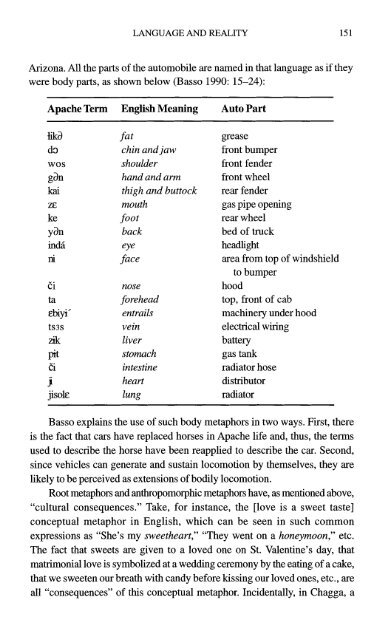A Basic Course in Anthropological Linguistics (Studies in Linguistic ...
A Basic Course in Anthropological Linguistics (Studies in Linguistic ...
A Basic Course in Anthropological Linguistics (Studies in Linguistic ...
Create successful ePaper yourself
Turn your PDF publications into a flip-book with our unique Google optimized e-Paper software.
LANGUAGE AND REALITY 151<br />
Arizona. All the parts of the automobile are named <strong>in</strong> that language as if they<br />
were body parts, as shown below (Basso 1990: 15-24):<br />
Apache Term English Mean<strong>in</strong>g Auto Part<br />
&a<br />
d=><br />
wos<br />
gan<br />
kai<br />
ZE<br />
ke<br />
Yan<br />
<strong>in</strong>di<br />
ni<br />
Ci<br />
ta<br />
Ebiyi’<br />
tS3S<br />
ztk<br />
pit<br />
6<br />
s<br />
jisole<br />
fat<br />
ch<strong>in</strong> and jaw<br />
shoulder<br />
hand and am thigh and buttock<br />
mouth<br />
foot<br />
back<br />
eye<br />
face<br />
nose<br />
forehead<br />
entrails<br />
ve<strong>in</strong><br />
liver<br />
stomach<br />
<strong>in</strong>test<strong>in</strong>e<br />
heart<br />
lung<br />
grease<br />
front bumper<br />
front fender<br />
front wheel<br />
rear fender<br />
gas pipe open<strong>in</strong>g<br />
rear wheel<br />
bed of truck<br />
headlight<br />
area from top of w<strong>in</strong>dshield<br />
to bumper<br />
hood<br />
top, front of cab<br />
mach<strong>in</strong>ery under hood<br />
electrical wir<strong>in</strong>g<br />
battery<br />
gas tank<br />
radiator hose<br />
distributor<br />
radiator<br />
Basso expla<strong>in</strong>s the use of such body metaphors <strong>in</strong> two ways. First, there<br />
is the fact that cars have replaced horses <strong>in</strong> Apache life and, thus, the terms<br />
used to describe the horse have been reapplied to describe the car. Second,<br />
s<strong>in</strong>ce vehicles can generate and susta<strong>in</strong> locomotion by themselves, they are<br />
likely to be perceived as extensions of bodily locomotion.<br />
Root metaphors and anthropomorphic metaphors have, as mentioned above,<br />
“cultural consequences.” Take, for <strong>in</strong>stance, the [love is a sweet taste]<br />
conceptual metaphor <strong>in</strong> English, which can be seen <strong>in</strong> such common<br />
expressions as “She’s my sweetheart,” “They went on a honeymoon,” etc.<br />
The fact that sweets are given to a loved one on St. Valent<strong>in</strong>e’s day, that<br />
matrimonial love is symbolized at a wedd<strong>in</strong>g ceremony by the eat<strong>in</strong>g of a cake,<br />
that we sweeten our breath with candy before luss<strong>in</strong>g our loved ones, etc., are<br />
all “consequences” of this conceptual metaphor. Incidentally, <strong>in</strong> Chagga, a






